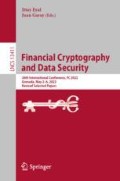Abstract
Bitcoin is based on a P2P network of which only a few quantities are publicly known. While the number of peers that disseminate transactions and blocks is relevant for the robustness of the network, only the number of reachable peers is so far being measured. However, there exists an unknown number of unreachable peers in the network, that is, peers that do not accept incoming connections but typically also disseminate transactions and blocks. We propose the Passive Announcement Listening (PAL) method that gives an estimate of the number of unreachable peers by observing peer announcements in addr messages. We use the PAL method to analyze data from a long-term measurement of the Bitcoin P2P network from 2015 to 2022. The PAL estimate shows that since 2018 the number of unreachable peers is at least three times higher than the number of reachable peers. An empirical validation indicates that about 76% of all unreachable peers announce their address and the PAL approach finds about 94% of these unreachable peers. Thus, we estimate the total number of unreachable peers in May 2022 to be around 34,000. We also report on a spam wave of addr messages that shows that peer announcements ‘leak’ even more information than the size of the network.
Access this chapter
Tax calculation will be finalised at checkout
Purchases are for personal use only
References
Biryukov, A., Khovratovich, D., Pustogarov, I.: Deanonymisation of Clients in Bitcoin P2P Network. In: Proceedings of the 2014 ACM SIGSAC Conference on Computer and Communications Security, pp. 15–29. CCS 2014, Association for Computing Machinery, New York, NY, USA, November 2014. https://doi.org/10.1145/2660267.2660379
Bitcoin-Developers: Bitcoin Reference (2019). https://developer.bitcoin.org/reference/index.html
Bitcoin-Developers: Bitcoin Glossary (2020). https://developer.bitcoin.org/glossary.html
Delgado-Segura, S., Pérez-Solà, C., Herrera-Joancomartí, J., Navarro-Arribas, G., Borrell, J.: Cryptocurrency Networks: A New P2P Paradigm. Mob. Inf. Syst. 2018(3), 1–16 (2018). https://doi.org/10.1155/2018/2159082
Donet Donet, J.A., Pérez-Solà, C., Herrera-Joancomartí, J.: The Bitcoin P2P network. In: Böhme, R., Brenner, M., Moore, T., Smith, M. (eds.) FC 2014. LNCS, vol. 8438, pp. 87–102. Springer, Heidelberg (2014). https://doi.org/10.1007/978-3-662-44774-1_7
DSN: Bitcoin Network Monitoring (2021). https://dsn.kastel.kit.edu/bitcoin/
Franzoni, F., Daza, V.: Improving Bitcoin Transaction Propagation by Leveraging Unreachable Nodes. In: 2020 IEEE International Conference on Blockchain (Blockchain), pp. 196–203 (2020). https://doi.org/10.1109/Blockchain50366.2020.00031
Garay, J., Kiayias, A., Leonardos, N.: The Bitcoin backbone protocol: analysis and applications. In: Oswald, E., Fischlin, M. (eds.) EUROCRYPT 2015. LNCS, vol. 9057, pp. 281–310. Springer, Heidelberg (2015). https://doi.org/10.1007/978-3-662-46803-6_10
Grundmann, M., Amberg, H., Hartenstein, H.: On the estimation of the number of unreachable peers in the Bitcoin P2P network by observation of peer announcements. arXiv preprint arXiv:2102.12774 (2021)
Grundmann, M., Baumstark, M., Hartenstein, H.: On the peer degree distribution of the Bitcoin P2P network. In: 2022 IEEE International Conference on Blockchain and Cryptocurrency (ICBC), pp. 1–5 (2022). https://doi.org/10.1109/ICBC54727.2022.9805511
Heilman, E., Kendler, A., Zohar, A., Goldberg, S.: Eclipse attacks on Bitcoin’s peer-to-peer network. In: Proceedings of the 24th USENIX Conference on Security Symposium, pp. 129–144. SEC2015, USENIX Association, USA (2015)
Imtiaz, M.A., Starobinski, D., Trachtenberg, A., Younis, N.: Churn in the Bitcoin Network. IEEE Trans. Netw. Serv. Manage. 18(2), 1598–1615 (2021). https://doi.org/10.1109/TNSM.2021.3050428
Nick, J.: Guessing Bitcoin’s P2P Connections (2015). https://jonasnick.github.io/blog/2015/03/06/guessing-bitcoins-p2p-connections/
van der Laan, W.J.: BIP 155: addrv2 message (2019). https://github.com/bitcoin/bips/blob/master/bip-0155.mediawiki
Luke-Jr: Bitcoin Node Count History (2021). https://luke.dashjr.org/programs/bitcoin/files/charts/historical.html
Miller, A., et al.: Discovering Bitcoin’s Public Topology and Influential Nodes (2015)
Nakamoto, S.: Bitcoin: A Peer-to-Peer Electronic Cash System. Tech. rep. (2008)
Naumenko, G., Maxwell, G., Wuille, P., Fedorova, A., Beschastnikh, I.: Erlay: efficient transaction relay for Bitcoin. In: Proceedings of the 2019 ACM SIGSAC Conference on Computer and Communications Security - CCS 2019, pp. 817–831. ACM Press, London, United Kingdom (2019). https://doi.org/10.1145/3319535.3354237
Neudecker, T., Andelfinger, P., Hartenstein, H.: Timing Analysis for Inferring the Topology of the Bitcoin Peer-to-Peer Network. In: Proceedings of the 13th IEEE International Conference on Advanced and Trusted Computing, pp. 358–367 (2016). https://doi.org/10.1109/UIC-ATC-ScalCom-CBDCom-IoP-SmartWorld.2016.0070
Neudecker, T.: Characterization of the Bitcoin Peer-to-Peer Network (2015–2018) (2019). https://doi.org/10.5445/IR/1000091933
Park, S., Im, S., Seol, Y., Paek, J.: Nodes in the Bitcoin network: comparative measurement study and survey. IEEE Access 7, 57009–57022 (2019). https://doi.org/10.1109/ACCESS.2019.2914098
Shahsavari, Y., Zhang, K., Talhi, C.: A theoretical model for block propagation analysis in Bitcoin network. IEEE Trans. Eng. Manage. PP(99), 1–18 (2020). https://doi.org/10.1109/TEM.2020.2989170
Tange, O.: GNU Parallel 20200522 (‘Kraftwerk’) (2020). https://doi.org/10.5281/zenodo.3841377
Wang, L., Pustogarov, I.: Towards Better Understanding of Bitcoin Unreachable Peers. arXiv preprint arXiv:1709.06837 (2017)
Yeow, A.: Bitnodes (2021). https://bitnodes.io
Acknowledgements
The authors would like to thank Till Neudecker and the anonymous reviewers for their feedback. The authors acknowledge support by the State of Baden-Württemberg through bwHPC. This work was supported by funding from the topic Engineering Secure Systems of the Helmholtz Association (HGF) and by KASTEL Security Research Labs.
Author information
Authors and Affiliations
Corresponding author
Editor information
Editors and Affiliations
Rights and permissions
Copyright information
© 2022 International Financial Cryptography Association
About this paper
Cite this paper
Grundmann, M., Amberg, H., Baumstark, M., Hartenstein, H. (2022). Short Paper: What Peer Announcements Tell Us About the Size of the Bitcoin P2P Network. In: Eyal, I., Garay, J. (eds) Financial Cryptography and Data Security. FC 2022. Lecture Notes in Computer Science, vol 13411. Springer, Cham. https://doi.org/10.1007/978-3-031-18283-9_35
Download citation
DOI: https://doi.org/10.1007/978-3-031-18283-9_35
Published:
Publisher Name: Springer, Cham
Print ISBN: 978-3-031-18282-2
Online ISBN: 978-3-031-18283-9
eBook Packages: Computer ScienceComputer Science (R0)

